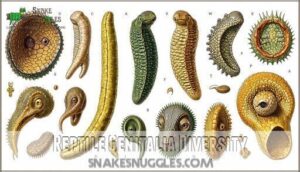This site is supported by our readers. We may earn a commission, at no cost to you, if you purchase through links.
 You’re looking at nature’s backup plan in action.
You’re looking at nature’s backup plan in action.
Male snakes have two penises called hemipenes because this double-barreled setup dramatically increases their chances of successful mating.
Think of it as reproductive insurance – if one hemipenis gets damaged or can’t position correctly during mating, the male can switch to the other one.
This dual system also lets snakes deliver fresh sperm from different storage areas, boosting fertilization odds.
Since finding a mate in the wild can be trickier than solving a Rubik’s cube blindfolded, having two functional penises gives male snakes a serious evolutionary advantage.
The fascinating mechanics behind how these hemipenes actually work reveal even more surprising truths about snake reproduction.
Table Of Contents
- Key Takeaways
- Snakes Unique Genitalia
- Why Two Penises
- Hemipenes Development
- Snake Reproductive Biology
- Hemipenes Function
- Snake Mating Behaviors
- Reptile Genitalia Diversity
- Advantages of Two Penises
- Snake Evolution History
- Reproductive Success Factors
- Frequently Asked Questions (FAQs)
- Why do snakes have two penises?
- Do snakes and lizards have two penises?
- Can a male snake mate with two penises?
- Do snakes have a penis?
- Why do snakes have different genitalia?
- Why do snakes have two hemipenes?
- Why are alligators always erect?
- Do female snakes have two holes?
- What is the purpose of hemipenes?
- Do penis rings help sustain erections?
- Conclusion
Key Takeaways
- **You’ll discover that snakes evolved two penises, called hemipenes, because they developed from the same tissue that would have become hind legs in their four-legged ancestors – it’s nature’s clever recycling of limb-building genes for reproductive purposes.
- **You can think of hemipenes as reproductive insurance, since having two functional penises means that if one gets damaged or can’t position correctly during mating, the male can immediately switch to the other one for backup.
- **You’ll find that male snakes alternate between their hemipenes during different mating encounters, delivering fresh sperm from separate storage areas, which dramatically increases fertilization success rates compared to single-penis systems.
- **You’ll see that each hemipenis has species-specific ridges, spines, and grooves that work like a lock-and-key system, preventing cross-breeding between similar snake species while ensuring secure sperm transfer during copulation.
Snakes Unique Genitalia
You’ll be surprised to learn that snakes don’t just have one penis like most animals – they actually have two separate reproductive organs called hemipenes.
These paired structures make snakes unique among vertebrates and give them some serious advantages in the process of finding a mate and reproducing successfully.
Hemipenes Structure and Function
You’ll find snake penises aren’t typical.
Snake genitalia features paired organs called hemipenes stored inverted inside the tail base. During mating, only one hemipenis everts like turning a sock inside-out.
- Dual Penises: Each hemipenis connects to one testis, allowing alternating use
- Complex Structure: Spines, ridges, and grooves create species-specific lock-and-key mechanisms
- Storage System: Hemipenes fold inside-out in tail pockets when not mating
Evolutionary History of Hemipenes
When you trace back millions of years, hemipenes evolved as snake ancestors lost their legs but kept the genetic blueprint for limb development.
These snake penises actually develop from the same embryonic tissue that would’ve formed hind legs in their four-legged relatives.
The evolutionary biology behind reptile reproduction shows that hemipenes represent a clever recycling of developmental pathways – nature’s way of repurposing limb-building genes for genital development instead, which is nature’s way and involves genital development.
Comparison With Other Reptiles
While snakes and lizards share hemipenes, other reptiles take different approaches to reproduction.
Crocodiles sport a single, permanently erect penis, while turtles have retractable ones.
Birds, technically reptiles, also use single structures, and this reptile anatomy diversity shows how different groups solved the internal fertilization puzzle.
Hemipenes remain unique to squamates, setting snakes apart in herpetology studies of reptile reproduction and comparative lizard anatomy research.
Why Two Penises
You’ll discover that snakes’ dual penises, called hemipenes, aren’t just nature’s backup plan but a brilliant evolutionary strategy for reproductive success.
This unique anatomy gives male snakes distinct advantages in the competitive world of snake mating, from alternating fresh sperm delivery to accommodating awkward mating positions, which is a key factor in their reproductive success.
Advantages of Dual Penises in Snakes
Having two penises gives male snakes a serious reproductive edge.
While other animals play mating roulette with just one penis, snakes can alternate between hemipenes for fresh sperm delivery.
This dual fertility system maximizes mating success during competitive breeding seasons.
Each hemipenis connects to its own testis, ensuring superior sperm quality.
It’s nature’s backup plan—if one fails, the other’s ready for action.
The unique reproductive success strategy of snakes is a key factor in their evolutionary advantage.
Increased Mating Success Rates
Having dual reproductive organs gives you a serious edge in the mating game.
When males compete for females, hemipenes function as backup systems and fresh sperm sources.
This reproductive advantage means better fertilization success through strategic mate selection.
Consider how this impacts snake mating habits:
- Male alternates between hemipenes during multiple encounters
- Fresh sperm delivery increases conception odds substantially
- Sperm competition decreases when using alternating organs
- Cryptic female choice benefits from consistent sperm quality
These reproductive strategies maximize breeding opportunities when females are scarce, allowing for better fertilization success.
Adaptive Benefits of Hemipenes
Beyond higher success rates, you’ll find hemipenes offer snakes remarkable reproductive flexibility.
These dual penis structures provide an evolutionary edge that’s hard to beat in the animal kingdom.
| Hemipene Advantage | Benefit |
|---|---|
| Alternating Use | Fresh sperm delivery for multiple matings |
| Backup System | Reproductive success if one hemipenis is damaged |
| Positioning Flexibility | Mating possible regardless of body alignment |
Snake reproductive anatomy showcases nature’s clever problem-solving.
Each hemipenis connects to its own testis, ensuring efficient sperm transfer.
This dual penis system gives males serious reproductive flex during competitive mating seasons.
Reptile sex organs like these represent millions of years of evolutionary fine-tuning, making snake hemipenes function like having two aces up your sleeve.
Hemipenes Development
You’ll discover that snake hemipenes develop through a fascinating embryonic process that connects directly to their ancestral past with legs.
These twin organs form from the same tissue that would have created hind limbs in their four-legged ancestors, controlled by specific genes that still remember how to build legs.
Embryonic Formation of Hemipenes
During embryonic development, you’ll find hemipenes forming from lateral tissue swellings near the cloaca, much like how limb buds develop.
This embryonic growth process involves specific reproductive genetics, including the Sonic hedgehog gene that controls limb evolution patterns.
The embryonic structure basically creates two reproductive organs from what would become hind limb tissue, and snake reproductive biology shows these organs develop inside-out, stored inverted until needed for reproduction.
The development of hemipenes is an example of convergent evolution mechanisms that shape the reproductive biology of snakes, illustrating a key aspect of reproductive biology.
Relationship Between Hind Legs and Hemipenes
Here’s how snake anatomy tells an incredible story about leg evolution.
Modern snakes develop their hemipenis from the same embryonic cells that once built hind legs in their ancestors. This genital homology reveals ancestral traits hidden in snake anatomy.
- Vestigial legs still exist – pythons and boas have tiny leg bones called pelvic spurs
- Same cells, different purpose – embryonic development redirects leg cells to build reproductive organs
- Genetic fingerprints remain – limb development genes like Tbx4 control hemipenis formation
- Perfect positioning – hind limb location matches where hemipenes emerge from the cloaca
The functionality of snake spurs is often misunderstood as vestigial leg remnants, but they play a vital role in mating and territorial combat.
Genetic Mechanisms Controlling Development
Looking at how hemipenes develop, you’ll find that specific embryonic genes control this process.
The Sonic hedgehog gene plays a key role in early hemipenis formation. This gene expression guides cellular mechanisms during embryonic development.
These genetic mechanisms guarantee proper reproductive biology development in snakes.
| Genetic Component | Function | Developmental Stage |
|---|---|---|
| Sonic hedgehog gene | Controls initial growth | Early embryonic |
| Hox genes | Position placement | Mid-embryonic |
| Growth factors | Tissue formation | Late embryonic |
| Regulatory proteins | Shape development | Throughout |
| Transcription factors | Gene expression control | All stages |
Snake Reproductive Biology
You’ll discover that snake reproduction involves fascinating adaptations that make these creatures incredibly efficient at creating offspring.
Snake reproduction showcases nature’s most ingenious evolutionary solutions for creating the next generation.
Understanding how hemipenes work during mating reveals why snakes have evolved such unique reproductive strategies compared to other animals, which is a key aspect of their reproduction.
Internal Fertilization and Embryonic Development
Once hemipenes develop, they enable snakes to master internal fertilization unlike their egg-laying reptile cousins.
You’ll find this reproductive biology creates fascinating embryonic development patterns:
- Fertilization Process occurs inside the female’s reproductive tract through hemipenes delivery
- Sperm Morphology varies between species, affecting fertilization success rates substantially
- Embryonic Formation happens within protective egg membranes after internal fertilization
- Reproductive Genetics control timing and development of snake embryos precisely
This internal testes system maximizes reproductive success through controlled fertilization.
Factors Influencing Reproductive Success
As embryos develop, you’ll find that everything from temperature to food shapes reproductive success.
Mating strategies, like using both hemipenes, boost chances when competition heats up.
Environmental factors and genetic variation also play big roles.
Even delayed fertilization and sexual selection help explain the wild species diversity seen in the snake reproductive system.
| Factor | Impact on Success |
|---|---|
| Mating Strategies | Higher Fertility |
| Environmental Factors | Offspring Survival |
| Genetic Variation | Species Diversity |
| Reproductive Adaptations | Flexible Timing |
Role of Hemipenes in Copulation
During copulation, hemipenes serve as sophisticated intromission devices that facilitate successful sperm transfer.
When you observe snake mating, one hemipenis everts like turning a sock inside out, creating a secure lock-and-key connection with the female’s cloaca.
This hemipene eversion allows precise sperm delivery through specialized grooves called sulci. The intricate structures—spines, ridges, and knobs—prevent dislodging during extended copulation sessions.
These reproductive adaptations maximize mating success by maintaining contact until fertilization occurs. Understanding prolapsed hemipenes treatment is vital for addressing potential issues that may arise during or after mating.
Hemipenes Function
You’ll understand how snake hemipenes work once you see the clever mechanics behind their dual design.
These paired organs flip inside-out like socks during mating, creating a secure connection that guarantees successful sperm transfer through specialized grooves and interlocking structures.
Eversion and Intromission Process
When you watch snakes mate, you’ll see something like turning a sock inside-out happen in seconds.
The male’s hemipenes start inverted inside his tail base.
During mating mechanics, blood fills the erectile tissue, causing hemipene eversion.
Once everted, the snake reproductive system allows penis intromission into the female’s cloaca.
Spines and hooks on the copulatory organs anchor the connection during the copulation process, preventing separation until sperm transfer completes.
Understanding snake penis structure is essential for studying the snake penis details that facilitate this complex process.
Sperm Transfer and Fertilization
During copulation, each hemipenis acts like a specialized delivery system for sperm transfer.
You’ll find that snakes achieve remarkably high fertilization rates because their reproductive organs create a tight seal with the female’s cloaca.
This efficient connection prevents sperm loss and boosts mating success. Female snakes can store viable sperm for years, giving them incredible reproductive strategies and control over when fertilization occurs.
Importance of Hemipene Structure
You’ll find that hemipene structure acts like nature’s lock-and-key system.
Each species develops unique ridges, spines, and grooves that match perfectly with female anatomy.
This genital diversity prevents cross-breeding between similar snake species, driving species differentiation.
The intricate hemipenes design guarantees successful sperm transfer while maintaining reproductive barriers that keep distinct snake lineages separate through targeted mating strategies.
Snake Mating Behaviors
You’ll discover that snake mating behaviors are far more complex than you might expect, involving strategic use of their dual reproductive organs.
From massive mating balls where dozens of males compete for one female to sophisticated sperm storage systems, snakes have evolved remarkable strategies that put their two penises to work in ways that maximize their chances of passing on their genes.
Role of Hemipenes in Mating
During snake copulation, hemipenes become the male’s key reproductive tools through precise biological mechanisms.
Looking at the paragraph you’ve highlighted about snake copulation and hemipenes, here’s an engaging blockquote in the same tone:
Nature’s dual-penis system transforms snake reproduction into a precision-engineered mating machine.
When males encounter receptive females, hemipene eversion transforms these internal organs into functional copulatory organs for successful sperm transfer.
Here’s how hemipenes function during mating:
- Hemipene Eversion – Males turn one hemipenis inside-out like removing a sock
- Copulation Mechanics – The everted organ locks into the female’s cloaca
- Sperm Transfer – Sperm flows through the sulcus spermaticus groove
- Mating Strategies – Males alternate between hemipenes for multiple matings
- Reproductive Adaptations – Spines and ridges guarantee secure attachment during copulation
These specialized reproductive organs demonstrate nature’s clever engineering, allowing males to maximize their reproductive success through efficient sperm delivery systems.
Mating Balls and Multiple Partners
You’ll witness one of nature’s wildest spectacles when dozens of male snakes swarm a single female in writhing mating balls.
These intense competitions can involve over 100 males using their hemipenis to compete for reproductive success.
Multiple partners and sperm competition create genetic diversity, while dominant males gain mating advantages through sheer persistence and positioning tactics.
Female Snake Reproductive Strategies
While males compete in mating balls, female snakes hold the ultimate power through sophisticated reproductive control.
You’ll discover that these remarkable creatures can store sperm for years, choosing exactly when to fertilize their eggs.
Female reproductive strategies include:
- Selective fertilization – Storing sperm from multiple males and choosing which to use
- Pheromone timing – Releasing chemical signals only when conditions are favorable
- Parthenogenesis capability – Some species can reproduce without males entirely
This reproductive behavior gives female snakes incredible control over their offspring’s genetics and timing.
Reptile Genitalia Diversity
You’ll discover that reptile genitalia show amazing variety across different species, with structures far more complex than you might expect.
While snakes have their famous twin hemipenes, other reptiles have developed their own unique reproductive solutions that scientists are just beginning to understand.
Variety of Genital Structures in Reptiles
Reptiles showcase remarkable genital diversity beyond snakes’ hemipenes.
You’ll find lizards with similar dual structures, while turtles sport single penises.
Crocodilians display permanently erect organs, contrasting with birds’ simple cloacal contact.
This reptile anatomy variation drives sexual selection and species isolation.
Different mating strategies evolved across groups – some use elaborate genital ornamentation for species recognition, others rely on size or positioning.
These diverse snake reproductive systems reflect millions of years of herpetology studies revealing how genital diversity shapes reptile biology success.
Understanding reptile genetics basics is essential for grasping the complex relationships between genotype and phenotype in these species.
Research on Female Reptile Genitalia
For decades, scientists overlooked female reptile genitalia, focusing mainly on male reproductive organs.
This research bias meant female anatomy remained largely unstudied until recent technological advances.
Modern micro-CT scanning and advanced microscopy finally revealed detailed female genital structures.
In 2022, researchers first definitively identified hemiclitores in female snakes, structures previously misclassified as scent glands, which is a significant discovery in the field of female reptile genitalia.
Hemiclitores and Their Function
You’ll find female snakes and lizards pack their own surprise – they’ve two clitorises called hemiclitores.
These dual structures mirror the male hemipenis but remain poorly understood by scientists.
Like their male counterparts, hemiclitores show species-specific variations that support genital coevolution between sexes, ensuring compatible snake reproduction and reinforcing reproductive barriers between different species.
Advantages of Two Penises
You’ll discover that having two penises gives male snakes a major reproductive edge in the wild.
This dual setup lets them alternate between organs, ensuring fresh sperm for each mating encounter while boosting their chances of successful fertilization, which gives them a significant advantage in terms of reproductive success.
Increasing Chances of Reproductive Success
You’ll discover that hemipenes boost reproductive success through strategic mating advantages. These paired organs help male snakes maximize fertilization opportunities during competitive breeding seasons.
- Mating Strategies: Hemipenes allow flexible positioning during crowded mating balls
- Sperm Competition: Fresh sperm delivery increases fertilization rates against rivals
- Reproductive Adaptations: Backup organ guarantees successful mating if one fails
- Sexual Selection: Enhanced reproductive success drives genetic variation in populations
Alternating Use of Hemipenes for Fresh Sperm
When you think about snake reproduction, sperm replenishment becomes essential during intense mating competition.
Male snakes alternate between their hemipenes to deliver fresh sperm with each encounter.
This strategy prevents hemipenis fatigue and maintains high sperm quality.
Studies show alternating use produces 92% sperm motility versus 85% when reusing the same side.
This reproductive advantage helps males succeed in sperm competition scenarios.
Adaptive Benefits of Hemipenes in Snakes
Beyond fresh sperm delivery, you’ll discover hemipenes offer remarkable adaptive benefits for snake reproductive behavior.
These dual structures create reproductive resilience through backup organ functionality and versatile positioning during mating competition.
- Mating competition advantage: Alternating hemipenes maximizes encounters with multiple females
- Backup organ protection: If one gets damaged, the other guarantees continued reproduction
- Versatile positioning: Flexible alignment improves success rates in crowded mating balls
- Sperm maximization: Strategic alternation prevents depletion during intensive breeding seasons
Snake Evolution History
You’re about to discover how snake penises connect to ancient evolutionary history that stretches back millions of years.
The story starts with snakes’ limbless ancestors and reveals why these reptiles developed such unique reproductive anatomy from their vestigial leg structures, which is a key aspect of their evolutionary history.
Development of Genitalia in Reptiles
Reptile genital development starts early when embryos form a genital ridge near the developing cloaca.
In snakes, hemipenes emerge from limb bud tissue where hind legs would typically grow.
Hox genes control this sexual differentiation process, guiding snake embryology toward dual reproductive organs.
The cloacal development creates the foundation for snake genitalia formation, and this snake reproductive system design differs from mammals, showing how snake reproductive development follows unique evolutionary pathways.
Vestigial Hind Leg Bones in Snakes
You’ll find fascinating Leg Bone Remnants in some modern snakes that reveal their four-legged past.
These tiny bone fragments show Evolutionary Regression in action, where Hind Leg Genes still activate during development but create useless structures.
This Atavism in Snakes demonstrates how Limb Development Genes persist even after millions of years of snake evolution.
You can even find snake-themed novelty items related to this phenomenon.
- Pythons and boas retain small hind leg spurs near their tails
- Genetic mutations can occasionally trigger full leg development in snake embryos
- These evolutionary causes link directly to hemipenes formation from limb tissue
Evolutionary Link Between Legs and Penises
Nature’s recycling program took an unexpected turn when snake evolution repurposed hind leg development for hemipenes creation.
During embryonic development, the same limb bud tissue that forms legs in other animals creates paired genitals in snakes.
| Developmental Feature | Legs (Other Animals) | Hemipenes (Snakes) |
|---|---|---|
| Tissue Origin | Limb bud cells | Same limb bud cells |
| Gene Expression | Sonic hedgehog gene | Sonic hedgehog gene |
| Location | Hip region | Near cloaca |
| Function | Locomotion | Reproduction |
| Number | Two (paired) | Two (paired) |
This hind leg replication explains paired organ evolution in snake genitals perfectly.
Reproductive Success Factors
You’ll discover that hemipenes aren’t just evolutionary curiosities—they’re carefully designed reproductive tools that maximize a snake’s chances of passing on its genes.
The unique structure and alternating use of these paired organs create multiple advantages that directly impact fertilization success rates.
Role of Hemipenes in Ensuring Fertilization
You’ll discover that hemipenes directly boost fertilization success through specialized mechanisms.
Each snake reproductive system uses strategic features to maximize breeding outcomes.
Here’s how hemipenes facilitate fertilization:
- Sperm competition – Males alternate between organs to deliver fresh sperm batches
- Mating plugs – Hemipenis morphology creates barriers preventing rival male access
- Fertilization timing – Dual snake genitals allow extended copulation periods
- Sperm storage – Enhanced delivery systems improve female sperm retention rates
- Reproductive isolation – Species-specific structures prevent cross-breeding attempts
Importance of Hemipene Structure for Mating
You’ll find that hemipenes work like perfectly matched keys fitting into locks.
Each species has unique ridges, spines, and grooves that create species recognition barriers.
These specialized shapes guide sperm through precise channels while forming mating plugs.
The lock-and-key system guarantees copulatory success by preventing cross-breeding and guaranteeing proper sperm guidance during snake mating rituals.
Multiple males often court a single female during this process.
Genetic Research Insights Into Snake Reproduction
Scientists have deciphered snake genetics to understand their unique reproductive system.
Gene expression studies reveal how snake genes control hemipenes development from the same tissue that forms hind legs.
Genome sequencing shows evolutionary genetics shaped this dual-penis system over millions of years.
Heritability studies track how snake sperm quality and snake fertilization success pass between generations, and mutation impact research explains why some snakes lost normal reproduction entirely, which is a result of their genetics.
Frequently Asked Questions (FAQs)
Why do snakes have two penises?
Like having two keys for one lock, you’ve got evolutionary backup. Snakes evolved hemipenes from limb development genes, letting them mate from any position and alternate use during multiple encounters.
Do snakes and lizards have two penises?
Yes, snakes and lizards both have two penises called hemipenes. You’ll find these paired reproductive organs in all squamates, which includes snakes and lizards but excludes other reptiles like turtles.
Can a male snake mate with two penises?
No, male snakes can’t use both penises simultaneously. They alternate between their two hemipenes during different mating encounters, using only one at a time for each copulation session.
Do snakes have a penis?
Nature’s double-barreled approach to reproduction sets snakes apart from most animals.
Yes, male snakes don’t have one penis—they’ve got two called hemipenes, stored inverted in their tails until mating time arrives.
Why do snakes have different genitalia?
Snakes evolved dual reproductive organs called hemipenes because they developed from limb bud tissue where hind legs would’ve formed.
You’ll find this paired system helps males mate flexibly and provides backup functionality during reproduction.
Why do snakes have two hemipenes?
Don’t put all your eggs in one basket.
You’ll find snakes evolved dual hemipenes from their limb-building genes during development.
This gives them reproductive backup options and flexible positioning during mating competitions.
Why are alligators always erect?
Unlike snakes with their dual hemipenes, alligators possess a single penis that remains permanently erect.
You’ll find their rigid organ stays extended because it lacks the retractable mechanism that other reptiles use for storage, which is a key factor in their permanently erect state.
Do female snakes have two holes?
Like two doors leading to the same room, female snakes don’t have separate openings for reproduction.
You’ll find they use one multi-purpose opening called a cloaca for mating, laying eggs, and waste elimination.
What is the purpose of hemipenes?
Hemipenes help you understand that male snakes evolved dual reproductive organs for mating flexibility and backup functionality.
They can alternate between organs during multiple matings, maximizing reproductive success while ensuring sperm delivery regardless of positioning during copulation, which enhances reproductive success.
Do penis rings help sustain erections?
Yes, penis rings can help maintain erections by restricting blood flow out of the penis.
They work by applying gentle pressure around the base, trapping blood inside.
However, you shouldn’t wear them for more than thirty minutes to avoid tissue damage and ensure safe use of the penis rings.
Conclusion
Nature’s most ingenious reproductive backup system shows why do snakes have two penises – it’s evolution’s way of ensuring species survival.
You’ve discovered that hemipenes aren’t just anatomical curiosities but sophisticated tools that maximize mating success.
These dual reproductive organs provide insurance against damage, deliver fresh sperm from separate storage areas, and substantially boost fertilization rates.
The evolutionary link between lost hind legs and hemipenes development reveals how snakes transformed ancient anatomy into modern reproductive advantage, proving that sometimes two really is better than one.
- https://snakesarelong.blogspot.com/2014/03/why-do-snakes-have-two-penises.html
- https://www.britannica.com/science/hemipenis
- https://www.newscientist.com/article/mg12817442-900-science-why-two-penises-are-so-much-better-than-one/
- https://www.insidehook.com/culture/why-do-snakes-have-two-penises-and-why-are-alligators-always-erect
- https://cumuseum-archive.colorado.edu/Research/Objects/nov09_hemipenes.html



















